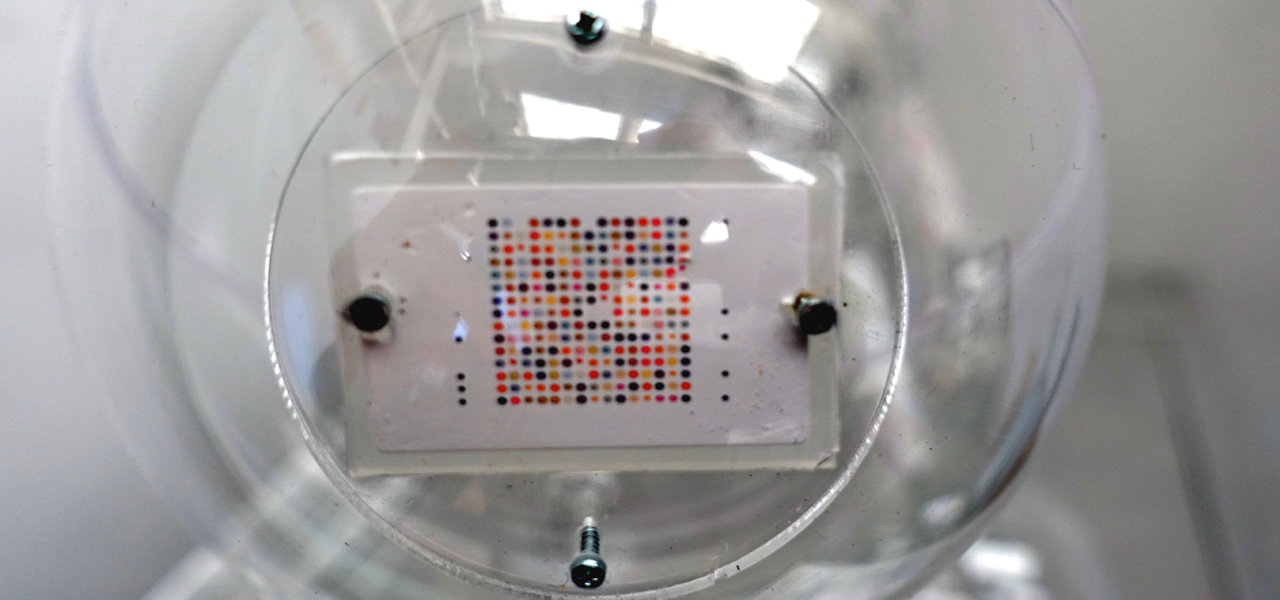
'A Chemistry of Colours'. 2023
#07 Valency : Participants : Licia Dossi
Law Enforcement Agencies around the world are under constant pressure to control the movement of criminal chemical substances more efficiently. This has led to a growing demand for detection equipment that is quick and easy to use, low cost to produce and maintain, and with the flexibility to identify a range of different substances.
Cranfield University have collaborated on the development of CRIM-TRACK, a prototype ‘mechanical sniffer dog’ that can support the fight against organised crime and terrorism and contribute to global security. The sniffer device is designed to detect traces of illegal drugs and explosives, and the chemicals used to make them, as parts-per-trillion, in near real-time and with no operator threat from contact.
It works by sniffing the air to detect the vapours given off by the chemicals. The device is loaded with a microchip printed with preselected dyes based on their chemo-selective nature. Using a technique known as colorimetric sensing, these dyes will undergo colour changes if exposed to vapours from the corresponding chemical. This colour change is captured by an algorithm developed by the team.
The data collected by CRIM-TRACK sniffer trials are organised into datasets, visualised in various difference maps (see pictures above) for inspection and interpretation of results. Machine learning models are used to learn the signature of the unknown chemicals and perform the detection.
The CRIM-TRACK project has specifically focused on areas where there is a growing safety risk to society, and the benefits of its use at locations such as airports and border inspection stations are clear to see. Current proposals for alternative uses for the sniffer device include both the detection of infectious airborne diseases and the presence of pesticides in National Archives items. The technology could also be applied in areas such as food production, manufacturing processes and environmental monitoring - to name but a few.
Dr Licia Dossi is Senior Lecturer in Defence Chemistry at Cranfield University and RSC Chartered Chemist and RSC Chartered Scientist, with expertise in materials chemistry gained from 30 years’ experience in UK and European Academic institutions.
She graduated with an MSc in Chemistry and received her PhD in Biomaterials from Pisa University, Italy. Licia moved to Bristol University UK in 1998 as Research Assistant with a three-year ESPRC grant in polymers and then took a career break for her young family until 2008 when she joined Cranfield University as Research Fellow.
Licia is currently part of the synthesis and formulation group at the Centre for Defence Chemistry at Shrivenham and delivers lectures at Master and PhD levels on a variety of themes including the detection of illicit chemicals (CRIM-TRACK project). She is active member of the Centre of Excellence in Energetic Materials - Detection and Synthesis groups and has an important national and international networking. She is an active researcher and co-author in more than 65 published papers/conference proceedings, 3 international patents and 3 books.
Clare Pratchett, Chris Murison and Matt Hodgson from the Creative Design team of Cranfield University in Shrivenham, are the fundamental contributors for delivering this hybrid chemistry-art project.
 Website: Crim-Trak
Website: Crim-Trak
